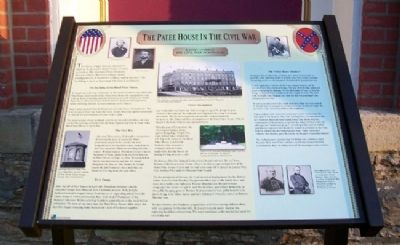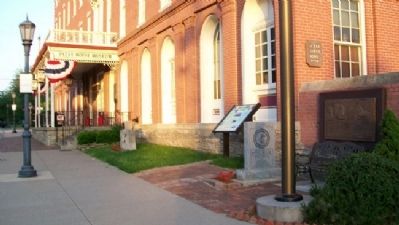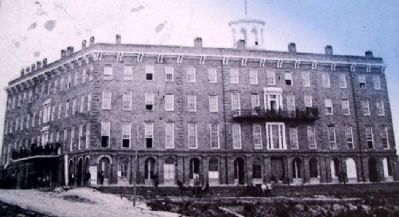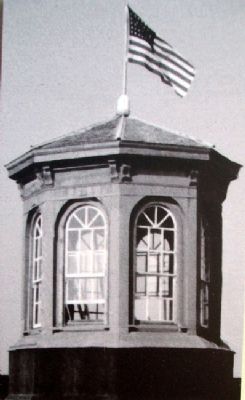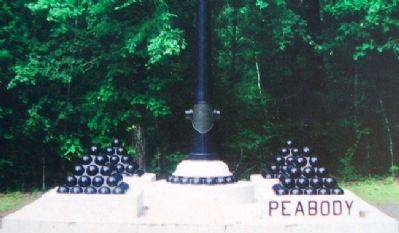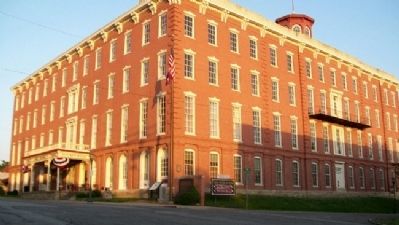St. Joseph in Buchanan County, Missouri — The American Midwest (Upper Plains)
The Patee House In The Civil War
A State Divided: The Civil War in Missouri
The Hotel Patee House opened in 1858 as St. Joseph’s finest hotel. It later served as the national Pony Express headquarters, the local Union Army headquarters, a women’s college and a factory. The building is now a National Historic Landmark.
The Opening of the Hotel Patee House
St. Joseph was a thriving community on the western border in 1856 when John Patee began construction on his Hotel Patee House. He equipped his hotel with the latest technology and a lavish interior at a cost of $200,000. Hotel Patee House offered westward bound visitors a last luxurious experience before enduring primitive accommodations on the frontier.
Patee’s hotel opened when St. Joseph was already a busy riverboat town. The town boomed when the Hannibal & St. Joseph Railroad opened and made St. Joseph the westernmost railroad stop in 1859.
The hotel became a local landmark and the site for political rallies and town events. The opening celebration for the Pony Express was held in front of Hotel Patee House in April 1860.
The Civil War
Like most Missourians, St. Joseph’s citizens were divided on the issue of secession. Many prominent people in the community were sympathetic to the Southern states, owned slaves and even supported Missouri seceding from the Union. William Seward, President Lincoln’s future Secretary of State, spoke from the front balcony of Patee House on Sept. 22, 1860. He warned that slavery was destined to end, but the crowd disagreed. On May 22, 1861, former St. Joseph mayor M. Jeff Thompson led a mob that cut down the U.S. flag from the post office.
First Camp
After the fall of Fort Sumter in April 1861, President Abraham Lincoln requested troops from Missouri Gov. Claiborne Jackson. In St. Joseph, Jackson’s refusal to supply troops fired rumors of impending attacks from the Union troops at Fort Leavenworth, Kan. Col. M. Jeff Thompson of the Missouri Volunteer Militia called up Southern sympathizers in the local militia companies. The men set up camp near the Hotel Patee House. After only a few days they began returning home because of a lack of food and supplies.
Union Occupation
Just weeks after war broke out, Union troops occupied St. Joseph to gain control of the railroad. The railroads were important for troop and supply movement. The Union occupation scattered the local secessionists. On June 10, 1861, Union soldiers commandeered the Hotel Patee House. Officers stayed in the hotel while troops camped nearby.
After the post office incident, the City Council made a decree against flying flags. Despite this, Capt. Alfred Sully ordered the U.S. flag to fly on top of the Hotel Patee House. Col. Everett Peabody, who recruited a company of local Union supporters, had the honor of raising the flag on June 11, 1861.
On June 15, 1861, Col. Samuel Curtis arrived by railroad with the 2nd Iowa Infantry. Like the previous Union officers, he also set up headquarters at the Hotel Patee House. Curtis and the 2nd Iowa soon left St. Joseph to pursue Maj. Gen. Sterling Price and the Missouri State Guard.
For the remainder of the war, the hotel served as headquarters for the district Union Army Provost Marshal. The provost office was on the fourth floor and trials were held in the ballroom. Provost Marshal Gen. Benjamin Loan designated the corner of 14th St. and Mitchell Ave., just a block from here, as the public hanging ground. Former St. Joseph mayor Gen. John Bassett, Gen. James Craig, Gen. Odon Guitar and Gen. Clinton B. Fisk also served as Provost Marshal here.
Tension between the Southern sympathizers and Union troops did not abate with occupation. In October 1861, St. Joseph was put under martial law, replacing local law enforcement. The town remained under martial law until the end of the war.
The Platte River Disaster
By August 1861, Confederate partisans, also called bushwhackers or guerillas, were operating in the St. Joseph area. Their tactics included disrupting service on the important Hannibal & St. Joseph Railroad.
In
early September, they burnt the lower support timbers of the 160-foot Platte River railroad bridge. The top of the bridge remained intact concealing the damage. On the dark night of Sept. 3, 1861, the bridge collapsed when a westbound train began to cross. The train with its freight cars, baggage car, mail car and two passenger cars plunged into the river.
At least 17 people died in the crash and more than 100 were injured. St. Joseph had no hospital at the time so rescue workers brought the survivors to the Hotel Patee House for treatment.
Union soldiers were ordered to arrest and execute bushwhackers for their part in the incident. Maj. Gen. Sterling Price, commander of the pro-Southern Missouri State Guard, wrote Gen. Henry Halleck, commander of Union forces, to protest the order. In Price’s view, the sabotage was “lawful and proper” according to the rules of warfare and that the captured men should be treated as prisoners of war. Gen. Halleck replied that the bushwhackers were “spies, marauders, robbers, incendiaries, guerrilla bands…in the garb of peaceful citizens.”
The bushwhackers claimed that the bridge was a military target because there were Union soldiers on the train bound for Fort Leavenworth, Kan. In reality, most of the passengers were civilians.
Erected by Missouri Department
of Natural Resources.
Topics and series. This historical marker is listed in these topic lists: Industry & Commerce • Settlements & Settlers • War, US Civil • Waterways & Vessels. In addition, it is included in the Former U.S. Presidents: #16 Abraham Lincoln, and the Missouri - A State Divided: The Civil War in Missouri series lists. A significant historical month for this entry is April 1860.
Location. 39° 45.369′ N, 94° 50.717′ W. Marker is in St. Joseph, Missouri, in Buchanan County. Marker is at the intersection of Penn Street and 12th Street, on the right when traveling east on Penn Street. Touch for map. Marker is at or near this postal address: 1202 Penn Street, Saint Joseph MO 64503, United States of America. Touch for directions.
Other nearby markers. At least 8 other markers are within walking distance of this marker. Patee House (here, next to this marker); Patee House - 1858 (here, next to this marker); The Pony Express (here, next to this marker); a different marker also named The Patee House (a few steps from this marker); Transcontinental Telegraph (a few steps from this marker); Jesse James Home (within shouting distance of this marker); Patee Park Baptist Church (about 800 feet away, measured in a direct line); Patee Town (approx. 0.2 miles away). Touch for a list and map of all markers in St. Joseph.
Also see . . .
1. Patee House Museum
. St. Joseph Missouri website entry (Submitted on September 21, 2011, by William Fischer, Jr. of Scranton, Pennsylvania.)
2. Missouri's Civil War. Website homepage (Submitted on September 21, 2011, by William Fischer, Jr. of Scranton, Pennsylvania.)
3. Platte Bridge Railroad Tragedy. Wikipedia entry (Submitted on April 27, 2022, by Larry Gertner of New York, New York.)
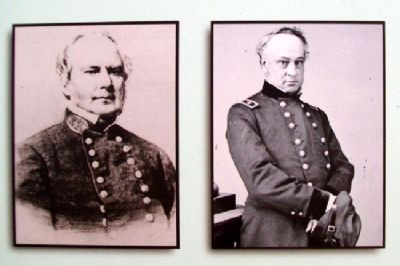
Photographed By Unknown, circa 1860s
6. Photos on The Patee House In The Civil War Marker
[Caption reads] Confederate Maj. Gen. Sterling Price, left, wrote to Union Gen. Henry Halleck, right, that the guerillas arrested for the Platte River disaster should be treated as prisoners of war. Courtesy Library of Congress
Credits. This page was last revised on April 27, 2022. It was originally submitted on September 21, 2011, by William Fischer, Jr. of Scranton, Pennsylvania. This page has been viewed 1,089 times since then and 30 times this year. Photos: 1, 2, 3, 4, 5, 6, 7. submitted on September 21, 2011, by William Fischer, Jr. of Scranton, Pennsylvania.
